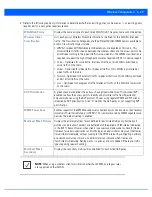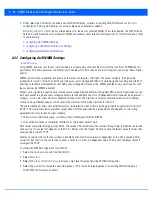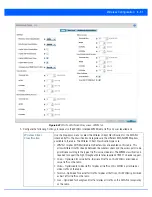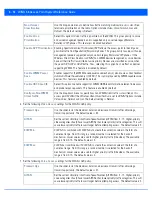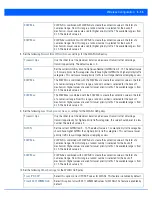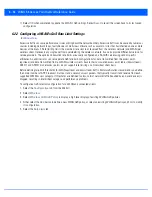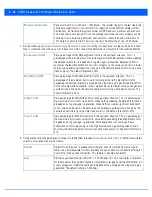
Wireless Configuration 6 - 63
Wireless network administrators can also assign weights to each WLAN in relation to user priority levels. The lower the
weight, the lower the priority. Use a weighted round robin technique to achieve different QoS levels across WLANs.
Optionally rate-limit bandwidth for WLAN sessions. This form of per-user rate limiting enables administrators to define uplink
and downlink bandwidth limits for users and clients. This sets the level of traffic a user or client can forward and receive over
the WLAN. If the user or client exceeds the limit, excessive traffic is dropped.
Rate limits can be applied externally from a RADIUS server using
Vendor Specific Attributes
(VSAs). Rate limits can be applied
to users authenticating using 802.1X, captive portal authentication and devices using MAC authentication.
6.3.1 Configuring a Radio’s QoS Policy
Radio QoS Policy
To configure an access point radio’s QoS policy:
1. Select the
Configuration
tab from the Web UI.
2. Select
Wireless.
3. Select
Radio QoS Policy
to display a high level display of existing Radio QoS policies.
Figure 6-26
Radio Quality of Service (QoS) screen
4. Refer to the following information for a radio QoS policy:
Radio QoS Policy
Displays the name of each radio QoS policy. This is the name set for each listed policy
when it was created and cannot be modified as part of the policy edit process.
Firewall detection traffic
(e.g., SIP)
A green check mark defines the policy as applying radio QoS settings to traffic detected
by the firewall used with the radio QoS policy. A red “X” defines the policy as having
firewall detection disabled. When enabled, the firewall simulates the reception of frames
for voice traffic when voice traffic was originated via SIP or SCCP control traffic. If a client
exceeds configured values, the call is stopped and/or received voice frames are forwarded
at the next non admission controlled traffic class priority. This applies to clients that do
not send TPSEC frames only.
Summary of Contents for WiNG 5.6
Page 1: ...Motorola Solutions WiNG 5 6 ACCESS POINT SYSTEM REFERENCE GUIDE ...
Page 2: ......
Page 22: ...8 WiNG 5 6 Access Point System Reference Guide ...
Page 26: ...1 4 WiNG 5 6 Access Point System Reference Guide ...
Page 38: ...2 12 WiNG 5 6 Access Point System Reference Guide ...
Page 74: ...3 36 WiNG 5 6 Access Point System Reference Guide ...
Page 468: ...6 2 WiNG 5 6 Access Point System Reference Guide Figure 6 1 Configuration Wireless menu ...
Page 568: ...6 102 WiNG 5 6 Access Point System Reference Guide ...
Page 614: ...7 46 WiNG 5 6 Access Point System Reference Guide ...
Page 660: ...8 46 WiNG 5 6 Access Point System Reference Guide ...
Page 716: ...9 56 WiNG 5 6 Access Point System Reference Guide ...
Page 730: ...10 14 WiNG 5 6 Access Point System Reference Guide ...
Page 982: ...14 20 WiNG 5 6 Access Point System Reference Guide ...
Page 984: ...A 2 WiNG 5 6 Access Point System Reference Guide ...
Page 1046: ...B 62 WiNG 5 6 Access Point System Reference Guide ...
Page 1047: ......

